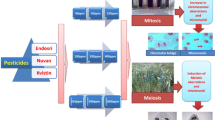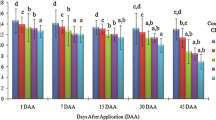Abstract
Background
Malathion (organophosphate) and cypermethrin (pyrethroid) are widely in use to facilitate protection of major food crops in agriculture, due to which it is important to understand their toxic potential. Allium cepa L. has been considered as a reliable genetic model to detect the toxicity of all sorts of pollutants.
Objective
The objective of the present work is to determine the cytotoxic and genotoxic effects of two widely used pesticides (malathion and cypermethrin) using A. cepa assay. Allium root growth inhibition test showed 0.5% concentration as the EC50 value in both the pesticides. In the toxicity experiment, 1/10 × EC50; 1/5 × EC50; EC50; 2 × EC50 and 3 × EC50 concentrations of both the pesticides along with a control were employed in Allium assay.
Results
Cytotoxic study showed mitotic index decreased with increasing the pesticides concentrations and exposure time. A series of mitotoxicity was observed under the influence of malathon and cypermethrin. Most types of chromosome aberrations observed in high percentage were stickiness, disturbance, c-metaphase, chromosome bridges in anaphase, lagging chromosome, and binucleate lesions. It was observed that malathion and cypermethrin are highly genotoxic to the onion, causing aberration at different phases of mitosis which can arrest cellular growth and may lead to senescence.
Conclusion
In conclusion, the present results showed that malathion and cypermethrin can get absorbed in the exposed plant parts or other non-target organisms in the vicinity, and may adversely affect their genomes, thus cause significant harm to crop plants and the environment as well.






Similar content being viewed by others
References
Amer SM, Mohammed FI, Ashry ZM (1999) Cytogenetic effects of the fungicide benomyl on Vicia faba and Pisum sativum. Bull Nat Res Cent Egypt 24:481–494
Amin R, Laskar RA, Khan S (2015) Assessment of genetic response and character association for yield and yield components in Lentil (Lens culinaris L.) population developed through chemical mutagenesis. Cogent Food Agric 1:1000715
Anis M, Shiran B, Wani AA (1998) Genotoxic effect of aldrin and malathion on the root meristem of Vicia faba. J Cytol Genet 33:35–42
Asita OA, Makhalemele R (2008) Genotoxicity of Chlorpyrifos, Alpha-thrin, Efekto virikop and Springbok to onion root tip cells. Afr J Biotechnol 7(23):4244–4250
Badr A, Ibrahim AG (1987) Effects of the herbicide glean on mitosis, chromosomes and nucleic acids in A. cepa and Vicia faba root meristems. Cytologia 52:293–302
Balog C (1982) The mitotic index in diploid and triploid Allium roots. Cytologia 47:689–697
CabreraCebulska-Wasilewska THMA, Chen R, Loarca F, Vandererg AL, Salamone MF (1994) Tradescantia-stamen-hair-mutation bioassay—a collaborative study on plant genotoxicity bioassays for the international program on chemical safety. WHO United Nations 310:211–220
Chutia J, Borah SP, Tanti B (2012) Effect of drought stress on protein and proline metabolism in seven traditional rice (Oryza sativa Linn.) genotypes of Assam, India. J Res Biol 2(3):206–214
Enan MR (2009) Genotoxicity of the herbicide 2,4-dichlorophenoxyacetic acid (2,4-D): higher plants as monitoring systems. Am Eurasian J Sustain Agric AEJSA 3:452–459
Environmental Protection Agency (EPA) (1992) Ethylene bisdithiocarbamates (EBDCs); notice of intent to cancel and conclusion of special review. Fed Reg 57(41):7434–7530
Evans HJ, Meary GJ, Tomkinson SN (1957) The use of colchicine as an indicator of mitotic rate in broad bean root meristem. J Genet 55:487–502
Fiskesjo G (1985) The Allium test as a standard in environmental monitoring. Hereditas 102:99–112
Fiskesjo G (1988) The Allium test—an alternative in environmental studies: the relative toxicity of metal ions. Mutat Res 197:243–260
Gadeva P, Dimitrov B (2008) Genotoxic effects of the pesticides Rubigan, Omite and Rovral in root-meristem cells of Crepis capillaris L. Genet Toxicol Environ Mutagen 652:191–197
Gomόrgen AN (2005) Cytological effect of the potassium metabisulphite and potassium nitrate food preservative on root tips of Allium cepa L. Cytologia 70:119–128
Hore P, Tanti B (2014) Karyomorphological studies of two morphotypes of Lasia spinosa (Lour.) Thwaites available in Assam, India. Ann Plant Sci 3(8):792–796
Inceer H, Hayirlioglu-Ayaz S, Ozcan M (2009) Relationship genotoxic effects of the insecticide cypermethrin on the root meristem cells of sunflowers (Helianthus annuus L.). Bull Environ Contam Toxicol 83:652–656. https://doi.org/10.1007/s00128-009-9856-8
Kishi M, Hirschhorn N, Djajadisastra M, Satterlee LN, Strowman S, Dilts R (1995) Relationship of pesticide spraying to signs and symptoms in Indonesian farmers. J Work Environ Health 21:124–133
Kluge R, Podlesak W (1985) Plant critical levels for the evaluation of boron toxicity in spring barley (Hordeum vulgare L.). Plant Soil 83:381–388
Konuk M, Liman R, Cigerci IH (2007) Determination of genotoxic effect of boron on Allium cepa root meristematic cells. Pak J Bot 39:73–79
Levan A (1938) The effect of colchine on root mitosis in Allium. Hereditas 24:471–486
Liman R, Akyıl D, Eren Y, Konuk M (2010) Testing of the mutagenicity and genotoxicity of metolcarb by using both Ames/Salmonella and Allium test. Chemosphere 80:1056–1061
Ma TH, Xu Z, Xu C, McConnell H, Rabago EV, Arreola GA, Zhang H (1995) The improved Allium/Vicia root tip micronucleus assay for clastogenicity of environmental pollutants. Mutat Res 334:185–195
Majer BJ, Grummt T, Uhl M, Knasmüller S (2005) Use of plant bioassays for the detection of genotoxins in the aquatic environment. Acta Hydrochim Hydrobiol 33:45–55
Mathur HB, Agarwal HC, Johnson S, Saikia N (2005) Analysis of pesticide residue in blood samples from village of Punjab. CSE Rep India 5:1–15
Mercykutty VC, Stephen J (1980) Adriamycin induced genetic toxicity as demonstrated by Allium cepa test. Cytologia 45:769–777
Mišik M, Solenska M, Mišcieta K, Mišikova K, Knasmuller S (2006) In situ monitoring of clastogenicity of ambient air in Bratislava, Slovakia using the Tradescantia micronucleus assay and pollen abortion assays. Genet Toxicol Environ Mutagen 605:1–6
Mozumder SN, Hossain MM (2013) Effect of seed treatment and soaking duration on germination of Eryngium foetidum L. seeds. Int J Hortic 3(10):46–51
Ozkara A, Akyıl D, Erdoğmus SF, Konuk M (2011) Evaluation of germination, root growth and cytological effects of wastewater of sugar factory (Afyonkarahisar) using Hordeum vulgare bioassays. Environ Monit Assess 183:517–524
Ozkara A, Akyıl D, Eren Y, Erdogmus SF (2015) Potential cytotoxic effect of Anilofos by using Allium cepa assay. Cytotechnology 67:783–791. https://doi.org/10.1007/s10616-014-9716-1
Patil BC, Bhat GI (1992) A comparative study on MH and EMS in the induction of chromosome aberration on root meristems of Clitoria ternata L. Cytologia 57:259–264
Permjit K, Grover IS (1985) Cytological effects of some organophosphorus pesticides II meiotic effects. Cytologia 50:199–211
Rank J, Nielsen MH (1997) Allium cepa anaphase–telophase root tip chromosome aberration assay on N-methyl-N-nitrosourea, malic hydradize, sodium azide, ethyl methyl sulfonate. Mutat Res 390:121–127
Rao BV, Narasimham TL, Subbarao MV (2005) Relative genotoxic effects of cypermethrin, alphamethrin and fenvalerate on the root meristems of Allium cepa. Cytologia 70(3):225–231
Sang N, Li G (2004) Genotoxicity of municipal landfill leachate on root tips of Vicia faba. Mutat Res 560:159–165
Sarma B, Tanti B (2014) Karyomorphological study of Stephania hernandifolia—a rare medicinal plant from Assam, India. Ann Plant Sci 3(11):869–872
Sarma B, Tanti B (2015) Karyomorphology of three species of Aristolochia—rare and endemic medicinal plants of Assam, India. Caryologia 68(2):154–158
Saxena PN, Chauhan LKS, Gupta SK (2005) Cytogenetic effects of commercial formulation of cypermethrin in root meristem cells of Allium sativum: spectroscopic basis of chromosome damage. Toxicology 216:244–252
Sharma AK, Sharma A (1965) Chromosome techniques: theory and practice. Butterworths, London
Tanti B, Buragohain AK, Dutta S, Gurung L, Shastry M, Borah SP (2009) Studies on the cytotoxic effect of oil refinery sludge on root meristem. Adv Environ Biol 3(1):10–14
Tanti B, Das AK, Kakati H, Choudhury D (2012) Cytotoxic effect of silver-nanoparticles on root meristem of Allium sativum L. J Res Nanobiotechnol 1(1):1–8
Thaís C, Dânia EC, Maria A (2007) Mechanism of micronuclei formation. Polyploidizated cells of Allium cepa exposed to trifluralin herbicide. Pestic Biochem Physiol 88(3):252–259
Toijam H, Borah SP, Tanti B, Borthakur SK (2013) Karyomorphological studies in two species of Allium L. J Res Plant Sci 2(2):213–221
Zhang WJ, Jiang FB, Ou JF (2011) Global pesticide consumption and pollution: with China as a focus. Proc Int Acad Ecol Environ Sci 1:125–214
Acknowledgements
We are thankful to the University of Science and Technology Meghalaya (USTM), India, for providing research facilities. The authors received no specific funds for this work.
Author information
Authors and Affiliations
Contributions
NS and HP: contributed to design and performance the experiments, and analysis and interpretation of observations and data; RAL: contributed to the conception, drafting and revision of the manuscript. All authors reviewed the manuscript.
Corresponding author
Ethics declarations
Conflict of interest
The authors declare no conflict of interest.
Additional information
Publisher's Note
Springer Nature remains neutral with regard to jurisdictional claims in published maps and institutional affiliations.
Rights and permissions
About this article
Cite this article
Sheikh, N., Patowary, H. & Laskar, R.A. Screening of cytotoxic and genotoxic potency of two pesticides (malathion and cypermethrin) on Allium cepa L.. Mol. Cell. Toxicol. 16, 291–299 (2020). https://doi.org/10.1007/s13273-020-00077-7
Accepted:
Published:
Issue Date:
DOI: https://doi.org/10.1007/s13273-020-00077-7




